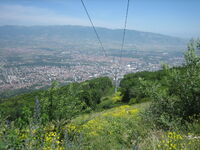Skopje (Macedonian: Скопје) is the capital and largest city of Macedonia. It is the country's political, cultural, economic, and academic center. It was known in the Roman period under the name Scupi.
The territory of Skopje has been inhabited since at least 4000 BC; remains of Neolithic settlements have been found within the old Kale Fortress that overlooks the modern city center. On the eve of the 1st century AD, the settlement was seized by the Romans and became a military camp. When the Roman Empire was divided into eastern and western halves in 395 AD, Scupi came under Byzantine rule from Constantinople. During much of the early medieval period, the town was contested between the Byzantines and the Bulgarian Empire, whose capital it was between 972 and 992. From 1282, the town was part of the Serbian Empire and acted as its capital city from 1346. In 1392, the city was conquered by the Ottoman Turks who renamed the town Üsküp. The town stayed under Ottoman control over 500 years, serving as the capital of Sanjak of Üsküb and later the Vilayet of Kosovo. At that time the city was famous for its oriental architecture. In 1912, it was annexed by the Kingdom of Serbia during the Balkan Wars and after the First World War the city became part of the newly formed Kingdom of Serbs, Croats and Slovenes (Kingdom of Yugoslavia). In the Second World War the city was briefly conquered by the Bulgarian Army, which was part of Axis powers until 1942. In 1944, it became the capital city of Macedonia as a federal state of Yugoslavia. The city developed rapidly after World War II. In 1961, it became the capital city of an independent Macedonia. The trend of growth was interrupted in 1963 when it was hit by a disastrous earthquake.
Skopje is located on the upper course of the Vardar River, and is located on a major north-south Balkan route between Belgrade and Athens. It is a center for metal-processing, chemical, timber, textile, leather, and printing industries. Industrial development of the city has been accompanied by development of the trade, logistics, and banking sectors, as well as an emphasis on the fields of culture and sport. According to the last official count from 2002, Skopje has a population of 506,926 inhabitants; according to an unofficial estimate for a more recent period, the city has a population of 668,518 inhabitants.
Geography[]

Skopje as seen from Mt. Vodno on June 12th, 2012.
Skopje is located in the north of the Republic of Macedonia, in the center of the Balkan peninsula, and halfway between Belgrade and Athens. The city is built in the Skopje valley, oriented on a west-east axis, along the course of the Vardar river, which flows into the Aegean Sea in Greece. The valley is approximately 12 miles (19.31 kilometers) wide and it is limited by several mountain ranges to the North and South. These ranges limit the urban expansion of Skopje, which spreads along the Vardar and the Serava, a small river which comes from the North. In its administrative boundaries, the City of Skopje stretches for more than 21 miles (33.8 kilometers), but it is only 6.2 miles (9.98 kilometers) wide.
Skopje is approximately 245 meters above sea level and covers 571.46 km2. The urbanized area only covers 337 km2, with a density of 65 inhabitants per hectare. Skopje, in its administrative limits, encompasses many villages and other settlements, including Dračevo, Gorno Nerezi and Bardovci. According to the 2002 census, the City of Skopje comprised 506,926 inhabitants, whereas the sole urban area only comprised 444,800 inhabitants.
The City of Skopje reaches the Kosovo border to the North-East. Clockwise, it is also bordered by the Macedonian municipalities of Čučer-Sandevo, Lipkovo, Aračinovo, Ilinden, Studeničani, Sopište, Želino and Jegunovce.
Climate[]
The climate of Skopje is usually classified as continental sub-Mediterranean, (Cfa under the Köppen climate classification) with a mean annual temperature of 13.5 °C (56 °F). Precipitation is relatively low due to the pronounced rain shadow of the Prokletije mountains to the northwest, being only a quarter of what is received on the Adriatic Sea coast at the same latitude. The summers are long, hot and humid. Skopje's average July high is 31 °C (88 °F). On average Skopje will see 88 days above 30 °C (86 °F) each year, and 10.2 days above 35.0 °C (95 °F) every year. Winters are short, relatively cold, and wet. Snowfalls are common in the winter period, but heavy snow accumulation is rare and the snowcover lasts only for a few hours or a few days if heavy. In summer, temperatures are usually above 31 °C (88 °F) and sometimes above 40 °C (104 °F). In spring and autumn, the temperatures range from 15 to 24 °C (59 to 75 °F). In winter, the day temperatures are roughly 6 °C (43 °F), but at nights they often fall below 0 °C (32 °F) and sometimes below −10 °C (14 °F). Typically, temperatures throughout one year range from −13 °C to 39 °C. Occurrences of precipitation are evenly distributed throughout the year, being heaviest from October to December and from April to June.
Twin cities[]
 Pittsburgh, America
Pittsburgh, America Tempe, America
Tempe, America Waremme, Belgium
Waremme, Belgium Sarajevo, Bosnia
Sarajevo, Bosnia Bradford, British Empire
Bradford, British Empire Sofia, Bulgaria
Sofia, Bulgaria Nanchang, Republic of China
Nanchang, Republic of China Pula, Croatia
Pula, Croatia Zagreb, Croatia
Zagreb, Croatia Suez, Egypt
Suez, Egypt Angoulême, France
Angoulême, France Dijon, France
Dijon, France Roubaix, France
Roubaix, France Dresden, Germany
Dresden, Germany Nuremberg, Germany
Nuremberg, Germany Ljubljana, Slovenia
Ljubljana, Slovenia Tashkent, Soviet Union
Tashkent, Soviet Union Zaragoza, Spain
Zaragoza, Spain Ankara, Turkey
Ankara, Turkey Istanbul, Turkey
Istanbul, Turkey Manisa, Turkey
Manisa, Turkey Belgrade, Yugoslavia
Belgrade, Yugoslavia Podgorica, Yugoslavia
Podgorica, Yugoslavia